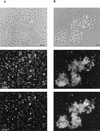Bacterial community dynamics during start-up of a trickle-bed bioreactor degrading aromatic compounds
- PMID: 9501433
- PMCID: PMC106348
- DOI: 10.1128/AEM.64.3.930-939.1998
Bacterial community dynamics during start-up of a trickle-bed bioreactor degrading aromatic compounds
Abstract
This study was performed with a laboratory-scale fixed-bed bioreactor degrading a mixture of aromatic compounds (Solvesso100). The starter culture for the bioreactor was prepared in a fermentor with a wastewater sample of a care painting facility as the inoculum and Solvesso100 as the sole carbon source. The bacterial community dynamics in the fermentor and the bioreactor were examined by a conventional isolation procedure and in situ hybridization with fluorescently labeled rRNA-targeted oligonucleotides. Two significant shifts in the bacterial community structure could be demonstrated. The original inoculum from the wastewater of the car factory was rich in proteobacteria of the alpha and beta subclasses, while the final fermentor enrichment was dominated by bacteria closely related to Pseudomonas putida or Pseudomonas mendocina, which both belong to the gamma subclass of the class Proteobacteria. A second significant shift was observed when the fermentor culture was transferred as inoculum to the trickle-bed bioreactor. The community structure in the bioreactor gradually returned to a higher complexity, with the dominance of beta and alpha subclass proteobacteria, whereas the gamma subclass proteobacteria sharply declined. Obviously, the preceded pollutant adaptant did not lead to a significant enrichment of bacteria that finally dominated in the trickle-bed bioreactor. In the course of experiments, three new 16S as well as 23S rRNA-targeted probes for beta subclass proteobacteria were designed, probe SUBU1237 for the genera Burkholderia and Sutterella, probe ALBO34a for the genera Alcaligenes and Bordetella, and probe Bcv13b for Burkholderia cepacia and Burkholderia vietnamiensis. Bacteria hybridizing with the probe Bcv13b represented the main Solvesso100-degrading population in the reactor.
Figures






Similar articles
-
Molecular diversity of mesophilic and thermophilic bacteria in a membrane bioreactor determined by fluorescent in situ hybridization with mxaF- and rRNA-targeted probes.J Basic Microbiol. 2003;43(3):202-9. doi: 10.1002/jobm.200390023. J Basic Microbiol. 2003. PMID: 12761771
-
Biofilm population dynamics in a trickle-bed bioreactor used for the biodegradation of aromatic hydrocarbons from waste gas under transient conditions.Biodegradation. 2004 Apr;15(2):133-44. doi: 10.1023/b:biod.0000015647.21321.df. Biodegradation. 2004. PMID: 15068374
-
Biodegradation of nonylphenol in a continuous bioreactor at low temperatures and effects on the microbial population.Appl Microbiol Biotechnol. 2006 Jan;69(5):597-606. doi: 10.1007/s00253-005-0067-x. Epub 2005 Jul 12. Appl Microbiol Biotechnol. 2006. PMID: 16010572
-
Upflow anaerobic sludge blanket reactor--a review.Indian J Environ Health. 2001 Apr;43(2):1-82. Indian J Environ Health. 2001. PMID: 12397675 Review.
-
A survey of the relative abundance of specific groups of cellulose degrading bacteria in anaerobic environments using fluorescence in situ hybridization.J Appl Microbiol. 2007 Oct;103(4):1332-43. doi: 10.1111/j.1365-2672.2007.03362.x. J Appl Microbiol. 2007. PMID: 17897237 Review.
Cited by
-
Microbial dioxygenase gene population shifts during polycyclic aromatic hydrocarbon biodegradation.Appl Environ Microbiol. 2006 Jun;72(6):4078-87. doi: 10.1128/AEM.02969-05. Appl Environ Microbiol. 2006. PMID: 16751518 Free PMC article.
-
Diversity of sulfate-reducing bacteria in oxic and anoxic regions of a microbial mat characterized by comparative analysis of dissimilatory sulfite reductase genes.Appl Environ Microbiol. 1999 Oct;65(10):4666-71. doi: 10.1128/AEM.65.10.4666-4671.1999. Appl Environ Microbiol. 1999. PMID: 10508104 Free PMC article.
-
Effect of microbial species richness on community stability and community function in a model plant-based wastewater processing system.Microb Ecol. 2006 Nov;52(4):725-37. doi: 10.1007/s00248-006-9105-1. Epub 2006 Oct 31. Microb Ecol. 2006. PMID: 17075733
-
Indigenous opportunistic bacteria inhabit mammalian gut-associated lymphoid tissues and share a mucosal antibody-mediated symbiosis.Proc Natl Acad Sci U S A. 2010 Apr 20;107(16):7419-24. doi: 10.1073/pnas.1001061107. Epub 2010 Apr 1. Proc Natl Acad Sci U S A. 2010. PMID: 20360558 Free PMC article.
-
Spatially oscillating activity and microbial succession of mercury-reducing biofilms in a technical-scale bioremediation system.Appl Environ Microbiol. 2002 Apr;68(4):1938-46. doi: 10.1128/AEM.68.4.1938-1946.2002. Appl Environ Microbiol. 2002. PMID: 11916716 Free PMC article.
References
-
- Amann R I, Ludwig W. Typing in situ with probes. In: Priest F G, et al., editors. Bacterial diversity and systematics. New York, N.Y: Plenum Press; 1994. pp. 115–135.
-
- Amann R I, Ludwig W, Schulze R, Spring S, Moore E, Schleifer K-H. rRNA-targeted oligonucleotide probes for the identification of genuine and former pseudomonads. Syst Appl Microbiol. 1996;19:501–509.
Publication types
MeSH terms
Substances
LinkOut - more resources
Full Text Sources
Other Literature Sources
Molecular Biology Databases

